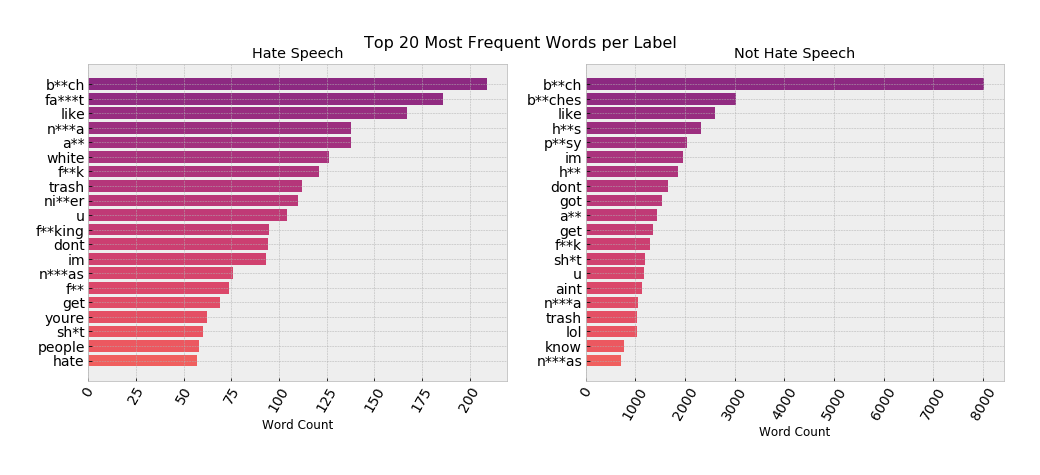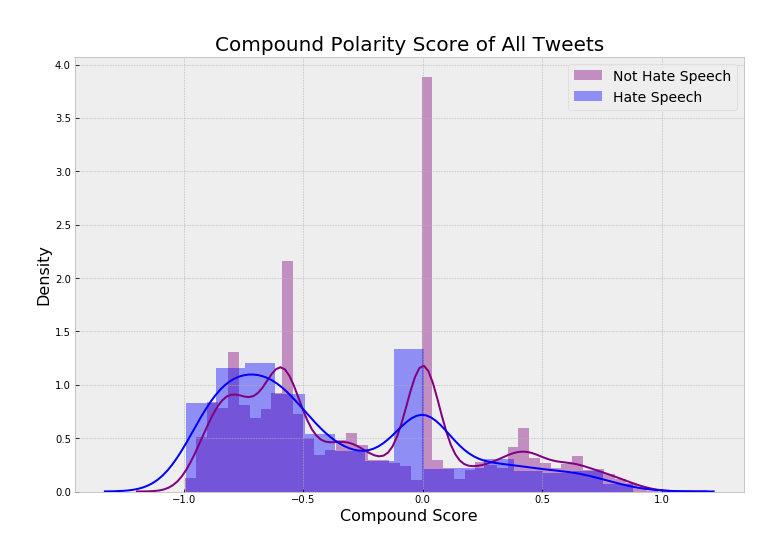This project aims to automate content moderation to identify hate speech using machine learning binary classification algorithms.
Human content moderation exploits people by consistently traumatizing and underpaying them. In 2019, an article on The Verge exposed the extensive list of horrific working conditions that employees faced at Cognizant, Facebook’s former moderation contractor. Unfortunately, every major tech company, including Twitter, uses human moderators to some extent, both domestically and overseas.
Hate speech is defined as abusive or threatening speech that expresses prejudice against a particular group, especially on the basis of race, religion or sexual orientation. Usually, the difference between hate speech and offensive language comes down to subtle context or diction.
Warning: All notebooks contain offensive language from the dataset.
The dataset for this capstone project was sourced from a study called Automated Hate Speech Detection and the Problem of Offensive Language conducted by Thomas Davidson and a team at Cornell University in 2017. The GitHub repository can be found here.
- The dataset is a
.csvfile with 24,802 text posts from Twitter where 6% of the tweets were labeled as hate speech - The labels on this dataset were voted on by crowdsource and determined by majority-rules
- To prepare the data for binary classification, labels were manually replaced by changing existing 1 and 2 values to 0, and changing 0 to 1 to indicate hate speech
| Column Name | Description |
|---|---|
| total_votes | number of CrowdFlower users who coded each tweet (minimum is 3, sometimes more users coded a tweet when judgments were determined to be unreliable by CF) |
| hate_speech_votes | number of CF users who judged the tweet to be hate speech |
| other_votes | number of CF users who judged the tweet to be offensive language or neither |
| label | class label for majority of CF user votes. 1 - hate speech 0 - not hate speech |
| tweet | raw tweets |
| clean_tweet | tweets filtered through NLP data cleaning process |
Linguistically, it's important to note that the difference between hate speech and offensive language often comes down to how it targets marginalized communities, often in threatening ways.
- Although the labels have very similar frequently occurring words, only 20% of the "Hate Speech" label is unique overall
- For instance, Hate Speech typically contains the N-word with the hard 'R'
- The use of this slur could indicate malicious intent, which goes beyond possibly using the word as cultural slang
Examples like that one demonstrate the nuances of English slang and the fine line between Hate Speech and offensive language. Because of the similarities of each label’s vocabulary, it could be difficult for machine learning algorithms to differentiate between them and determine what counts as hate speech.
We can see some more parallels and differences between what is classified as hate speech or not.
- #tcot stands for "Top Conservatives On Twitter” and it appears in both groups
- #teabagger, which refers to those who identify with the Tea Party, that is primarily (but not exclusively) associated with the Republican Party, only appears in the “Not Hate Speech” cloud
- Both hashtags are used among Alt-Right communities
- #r**skins, the former Washington NFL team name, only appears in the Not Hate Speech cloud
- This hashtag demonstrates how similar "offensive language" could be to "Hate Speech"
From this, it's recommended that Twitter should closely monitor those top hashtags for potential posts containing hate speech or even regular offensive language.
The compound polarity score is a metric that calculates the sum of all the lexicon ratings which have been normalized between -1 and +1. With -1 being extreme negative and +1 being extreme positive. This score encompasses the overall sentiment of this corpus.
- Hate Speech tweets on average have a compound score of -0.363
- Non Hate Speech tweets on average have a compound score of -0.263
According to this metric, both classes of tweets have pretty negative sentiments because their normalized compound scores are less than the threshold of -0.05.
Additionally from this graph, we can see that tweets classified as Hate Speech are especially negative. This further emphasizes how slim the difference between the two labels are.
To further develop this project, here are some immediate next steps that anyone could execute.
- Collect more potential "Hate Speech" data to be labeled by CrowdFlower voting system
- Improve final model with different preprocessing techniques, such as removing offensive language as stop words
- Evaluate model with new tweets or other online forum data to see if it can generalize well
- LDA Topic Modeling with Gensim
.
├── models # contains model iterations
├── pages # contains all webpages for different input formats
├── pickle # contains cleaned data
│ └── final_model.pkl # pickled final model
├── preprocessing # contains all data preparation iterations and EDA
├── src # source folder
│ └── twitter.csv # raw dataset
│ └── utils.py # contains utility functions
├── visualizations # contains visualizations and local images
├── README.md # public-facing preview process
└── Home.py # interactive dashboard to host project- See the full project overview in the
final_notebook.ipynbJupyter Notebook.
Data Source
- Davidson, T., Warmsley, D., Macy, M. and Weber, I., 2017. Automated Hate Speech Detection and the Problem of Offensive Language. ArXiv,.
Packages
- Hutto, C.J. & Gilbert, E.E. (2014). VADER: A Parsimonious Rule-based Model for Sentiment Analysis of Social Media Text. Eighth International Conference on Weblogs and Social Media (ICWSM-14). Ann Arbor, MI, June 2014.


